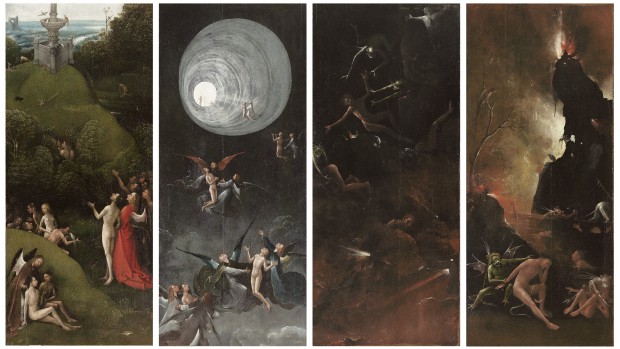The 20th-century painter who called himself Balthus once proposed that a monograph about him should begin with the words ‘Balthus is a painter of whom nothing is known. Now let us look at the pictures.’ But while Balthus may have felt that far too much was known about his private life, Hieronymus Bosch is an artist about whom we truly know if not exactly nothing then very little that is personal or revealing. He adopted his name from his native town, ’s-Hertogenbosch, where his death 500 years ago is marked by a superb exhibition. Bosch (c.1450–1516) was christened Jheronimus — alternatively Joen or Jeroen — van Aken, came from a family of painters and died, perhaps of an epidemic disease, aged about 65. And that, apart from a few mundane details, is almost all the information that survives — except for one credo. At the top of a drawing he wrote the words ‘Poor is the mind that always uses the inventions of others and invents nothing itself.’
In that respect — wildly imaginative brainstorming — Bosch’s mind was fabulously rich. The image he drew underneath that sentence is a case in point. It is an illustration of a proverb, ‘The wood has ears, the field has eyes,’ meaning keep quiet about your business. Bosch, however, has interpreted it both literally and — to use a term from a much later period of art — surreally.
Against the trunks of a small thicket of trees are leaning a couple of monstrous, detached ears. The ground in front sprouts eyes, and in the centre is a hollow tree from which a huge owl — a bird that the painter was particularly fond of depicting — stares out. In the catalogue it is suggested this image may have been a private manifesto. The wood from which he took his name — ’s-Hertogenbosch means ‘the Duke’s forest’ — is made into a place of bizarre transformation. And phantasmagoria was, to put it simply, Hieronymus Bosch’s shtick.
Without it, as a painter of relatively straightforward religious scenes, he was indeed a little dull. The current exhibition —which moves on to the Prado, Madrid, later in the year — presents a mass of conclusions by a team of specialist scholars. Their efforts to sort what is really the work of the great man are both impressive and persuasive. One of the glories of the exhibition is the way it reassembles two multipanelled altarpieces, which had been sawn up and dispersed centuries before. It turns out, however, that some fine and famous pictures are not by him — such as the ‘Christ Carrying the Cross’ in Ghent — and some fairly run-of-the-mill ones are.
An example of the latter is the early ‘Adoration of the Magi’ (c.1470–80). It shows, perhaps, how Bosch started out: as a provincial artist working somewhat in the idiom of famous painters from further south such as Rogier van der Weyden. ’s-Hertogenbosch, though a lovely little city, was and still is a relative backwater. Bosch, however, made himself and his hometown famous through sheer power of imaginative invention. Part of his talent was for the creation of effects you could call atmospheric — almost romantic. There is a hint of his true powers in the landscape in the background of the ‘Adoration of the Magi’, which recedes into a vast, misty distance. This capacity for rendering light and air had become apocalyptic and visionary by the time he painted four panels dubbed ‘Visions of the Hereafter’ (c.1505–15).
In one of these the blessed fly upwards towards a tunnel of light — concentric circles with the brightest in the middle — the most compelling visualisation of a journey to heaven in all of art. Even more riveting, though, are the panels depicting hell, a place of turbid darkness, in which whiskered, bat-winged demons grasp and torment sinners. A high rock with a bird perched on it is silhouetted against a black infernal sky filled with sparks, flame and flurries of smoke.
Obviously, Hell was Bosch’s thing, and he made it look if not exactly fun then certainly entertaining. It was surely the pleasure of looking at his scenes of sin and eternal punishment, rather than the moral message, that quickly won Bosch a European reputation (those ‘Visions of the Hereafter’ were bought by a Venetian cardinal early in the 16th century). His major works dwelled on the follies of humanity, and their dreadful consequences. This is the theme of ‘The Haywain’ (c.1510–15), in which devilish creatures, including a fish with legs, drag a wagon piled with straw. The people of the world scrabble for this worthless stuff. To the right is their likely destination, a place of fiery torment. Nonetheless, it is an utterly beguiling spectacle.
His art was a cornucopia of the bizarre. Such images, the drawings suggest, tumbled from his mind, and were then carefully preserved and anthologised. One little sheet contains, among other items, a man crouching head-first in a basket, from whose naked buttocks a flock of birds is emerging. Perched above is a figure poised to whack this ornithologically productive behind with a lute. What does it mean? Perhaps nobody ever knew or cared.
His fertile fantasy would not be so mesmerising had Bosch not been such a magician with the brush. The delicacy and energy of these paintings is what made it all work. By putting together so many of his remaining pictures, and reassembling some far-flung fragments, this exhibition makes Bosch’s achievement clearer than it was before. For the next two months, a visit to ’s-Hertogenbosch should be a high priority for lovers of weird, sinister and delightfully fanciful art.










Comments